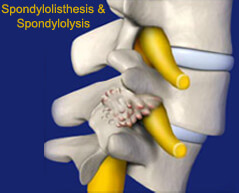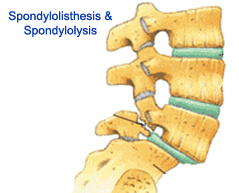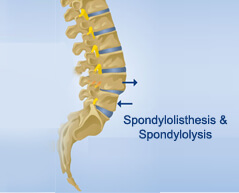Spondylolisthesis
 Displacement of a vertebra, especially the fifth lumbar vertebra, most commonly occurring after a break or fracture is known as Spondylolisthesis. In simple words, Spondylolisthesis is a condition in which one bone in the patient's vertebra slides forward over the bone below it. It most often occurs in the lower spine. In some cases, this may lead to the concerned patient's spinal cord or nerve roots being squeezed. This can cause patient back pain and numbness or weakness in one or both legs. In rare cases, it can also lead to losing control over your bladder or bowels. Backward displacement is called retrolisthesis.
Displacement of a vertebra, especially the fifth lumbar vertebra, most commonly occurring after a break or fracture is known as Spondylolisthesis. In simple words, Spondylolisthesis is a condition in which one bone in the patient's vertebra slides forward over the bone below it. It most often occurs in the lower spine. In some cases, this may lead to the concerned patient's spinal cord or nerve roots being squeezed. This can cause patient back pain and numbness or weakness in one or both legs. In rare cases, it can also lead to losing control over your bladder or bowels. Backward displacement is called retrolisthesis.
Sometimes when a vertebra slips out of place, you may have no symptoms at all or no symptoms until years later. Then, you may have pain in your low back or buttock. Muscles in your leg may feel tight or weak. You may even limp. The bones in your spine come together at several small joints that keep the bones lined up while still allowing them to move which causes spondylolisthesis.
It is caused by a problem with one or more of these small joints that allows one bone to move out of line. The problem may be caused by any of a number of problems with the small joints in your back. A patient could have:
- A defective joint that he had since birth which is called congenital.
- Or a joint damaged by an accident or other trauma.
- Or a vertebra with a stress fracture caused from overuse of the joint.
- Or a joint damaged by an infection or arthritis.
The problem affects children and is common amongst teens involved in sports. Some sports, such as gymnastics or weightlifting and powerligtinh, can overuse back bones to the point of causing stress fractures in vertebrae, which can result in spondylolisthesis. Older adults can develop spondylolisthesis, because wear and tear on the back leads to stress fractures. It can also occur without stress fractures when the disc and joints are worn down and slip out of place.

Planning your medical trip to India is a very simple process with Spine and Neuro Surgery Hospital India
- You just need to fill in our enquiry form and one of our executive will contact you soon.
- +91-9325887033 Call us at the given to contact number for any assistance.
- Complete information regarding surgery is provided on our website.
 The priliminary symptoms are common. It may include back or buttock pain, pain that runs from the lower back down one or both legs, numbness or weakness in one or both legs. The patient may find it difficult walking and the lg, back, or buttock pain that gets worse when you bend over or twist. In rare cases, there is loss of bladder or bowel control. Sometimes spondylolisthesis causes no symptoms at all.
It is said that the variant "listhesis," resulting from division of this compound word, is sometimes applied in conjunction with scoliosis.[unreliable medical source. These "slips" occur most commonly in the lumbar spine. Spondylolysis (a defect or fracture of the pars interarticularis of the vertebral arch) is the most common cause of spondylolisthesis, which should not be confused with a slipped disc, in which one of the spinal discs in between the vertebrae has ruptured.
The priliminary symptoms are common. It may include back or buttock pain, pain that runs from the lower back down one or both legs, numbness or weakness in one or both legs. The patient may find it difficult walking and the lg, back, or buttock pain that gets worse when you bend over or twist. In rare cases, there is loss of bladder or bowel control. Sometimes spondylolisthesis causes no symptoms at all.
It is said that the variant "listhesis," resulting from division of this compound word, is sometimes applied in conjunction with scoliosis.[unreliable medical source. These "slips" occur most commonly in the lumbar spine. Spondylolysis (a defect or fracture of the pars interarticularis of the vertebral arch) is the most common cause of spondylolisthesis, which should not be confused with a slipped disc, in which one of the spinal discs in between the vertebrae has ruptured.
A hangman's fracture is a specific type of spondylolisthesis where the second cervical vertebra (C2) is displaced anteriorly relative to the C3 vertebra due to fractures of the C2 vertebra's pedicles.
Spondylolisthesis is categorized into five types:
Isthmic spondylolisthesis is the most common form; also called spondylolytic spondylolisthesis, it occurs with a reported prevalence of 5-7 percent in the US population. A slip or fracture of the intravertebral joint is usually acquired between the ages of 6 and 16 years, but remains unnoticed until adulthood. Roughly 90 percent of these isthmic slips are low-grade (less than 50 percent slip) and 10 percent are high-grade (greater than 50 percent slip).
Degenerative spondylolisthesis is a disease of the older adult that develops as a result of facet arthritis and joint remodeling. Joint arthritis, and ligamentum flavum weakness, may result in slippage of a vertebrae. Degenerative forms are more likely to occur in women, persons older than fifty, and African-Americans. Traumatic spondylolisthesis is rare and results from acute fractures in the neural arch, other than the pars.
Get Low Cost Spondylolisthesis Surgery in India
We offer free assistance to international patients to find best medical treatment in India. We offer low-cost, world-class medical treatment in India, coordinated by a team of experienced service industry professionals
Please post a query to know about low cost treatment options at top India hospitals
Click Here
Pathologic spondylolisthesis has been associated with damage to the posterior elements[which?] from metastases or metabolic bone disease. These slips have been reported in cases of Paget's disease of bone, tuberculosis, giant-cell tumors, and tumor metastases. Dysplastic spondylolisthesis is a rare congenital spondylolisthesis occurring because of a malformation of the lumbosacral junction resulting in small, incompetent facet joints.
A general stiffening of the back and a tightening of the hamstrings, with a resulting change in both posture and gait. A leaning-forward or semi-kyphotic posture may be seen, due to compensatory changes. A waddle may be seen in more advanced causes, due to compensatory pelvic rotation due to decreased lumbar spine rotation. A result of the change in gait is often a noticeable atrophy in the gluteal muscles due to lack of use. Generalized lower-back pain may also be seen, with intermittent shooting pain from the buttocks to the posterior thigh, and/or lower leg via the sciatic nerve.
 Other symptoms may include tingling and numbness. Coughing and sneezing can intensify the pain. An individual may also note a slipping sensation when moving into an upright position. Sitting and trying to stand up may be painful and difficult.[medical citation needed]
Treatment of isthmic spondylolisthesis is controversial. Patients with symptomatic isthmic spondylolisthesis are initially offered conservative treatment consisting of activity modification, pharmacological intervention, and a physical therapy consultation.
Physical therapy can evaluate and address postural and compensatory movement abnormalities.[medical citation needed]
Other symptoms may include tingling and numbness. Coughing and sneezing can intensify the pain. An individual may also note a slipping sensation when moving into an upright position. Sitting and trying to stand up may be painful and difficult.[medical citation needed]
Treatment of isthmic spondylolisthesis is controversial. Patients with symptomatic isthmic spondylolisthesis are initially offered conservative treatment consisting of activity modification, pharmacological intervention, and a physical therapy consultation.
Physical therapy can evaluate and address postural and compensatory movement abnormalities.[medical citation needed]
There are many hospitals in India, Delhi and Nagpur, in specific, that provide treatment at an affordable price. The cost of surgeries is comparatively less in hospitals like Spine and Neuro Surgery Hospital in Nagpur which provide efficient treatment for spondylolisthesis. Anti-inflammatory medications (NSAIDS) in combination with acetaminophen (Tylenol) can be tried initially. If a severe radicular component is present, a short course of oral steroids such as Prednisone or Methylprednisolone can be considered. Epidural steroid injections, either interlaminarl or transforaminal, performed under fluoroscopic guidance can help with severe radicular (leg) pain. Lumbosacral orthoses may be of benefit for some patients but should be used on a temporary basis to prevent spinal muscle atrophy and loss of proprioception. Degenerative spondylolisthesis with spinal stenosis is one of the most common indications for spine surgery among older adults.
A large number of people have a positive result from surgery but like other surgeries, spinal surgery also carries some risks. Potential complications can be relatively minor, such as an infection at the operation site, to the more serious like permanent damage to the spinal nerves. Before choosing a spinal surgery, the surgeon will discuss the possible risks and benefits. It is important to choose the right surgeon. Spine and Neurosurgery Hospitals in India, especially in metropolitan cities like Delhi and Nagpur, provide promising treatment for Spondylolisthesis problems. Also the major boost factor is the lesser price. The overall expenses of treatment in India may cost as low as 25 % of what one may have to incur in the western countries, with the same excellence and efficiency in treatment.
What services we offer to our International Patient?
- Straight forward - simple booking procedure to seek top Medical Treatmentin India.
- Full assistance to get Medical Visa.
- Low cost - a fraction of the cost of UK/USA surgery.
- Low risk - world's highest standards of clinical care & surgery.
- Fast efficient service - immediate treatment with no waiting lists.
- Full patient support service - 24/7 services.
- Specialist consultations - scans, clinical investigations & consultations at short notice.
- Individual time to each patient
- Patients without insurance are equally benefitted
- Provides the world’s highest standards of clinical care & surgery.
- Receive the travelers at the airport
- Keep track of the additional requirements (if discovered during the treatment) and organize interventions accordingly to strive to ensure that the treatment process does not get disrupted.
- Handhold the travelers during their shopping/sight-seeing tours - we may or may accompany the travelers, but we coordinate for a smooth and pleasurable experience (at extra cost)
- In case the patient/attendant are English-constrained, then provide interpreter services Quick response and availability of revert.
- Visible compassion for the traveler.
How to plan your medical trip to India?
- Send us your query and medical reports
- Get the advised opinion and treatment plan from us within 48 hours from multiple hospitals
- Choose your preferred hospital and clear your concerns if you have any
- We will assist you with medical VISA, Vaccination, FRRO, Travel, Accommodation and Logistic Process
- Arrival arrangements will be done for your pick up at the airport based on your itinerary
- Treatment will start at the hospital as planned
- Once the treatment is done, you can fly back
- Post treatment follow up and consultation will be done by us via email, phone, Skype
